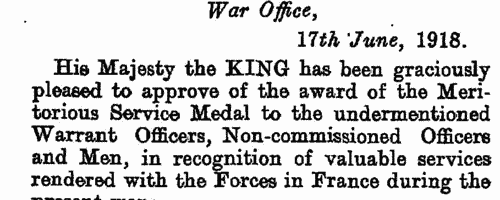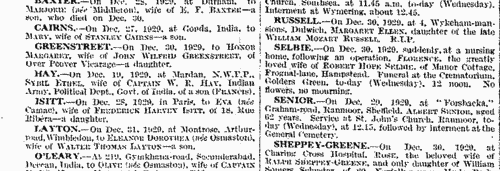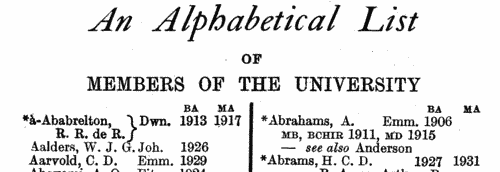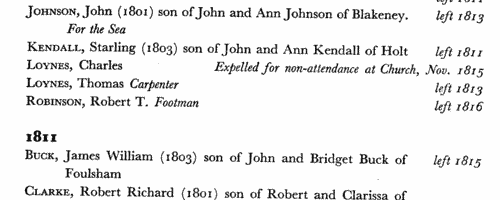Add this eBook to your basket to receive access to all 222 records. Our indexes include entries for the spelling scholey. In the period you have requested, we have the following 222 records (displaying 201 to 210): These sample scans are from the original record. You will get scans of the full pages or articles where the surname you searched for has been found. Your web browser may prevent the sample windows from opening; in this case please change your browser settings to allow pop-up windows from this site. Gardeners of Country Houses in Staffordshire
(1917)
The Horticultural Directory and Year Book was published for 57 years by the proprietors of the Journal of Horticulture, but for 1917 it was acquired by the Gardeners' Chronicle, and a complete revision was undertaken. 'In order to ensure the accuracy of the entries, enquiries were sent to every one of the many thousand persons whose names appeared in the lists. Nor did the work cease there, for in cases where no reply was received, a second enquiry, and in some instances even a third, was sent out. Inasmuch as the War has called many gardeners from their normal avocations, it was not possible to obtain information with respect to all the changes which occurred during the year, and particularly during the closing months. It became necessary, therefore, either to go to press with a certain number of unverified entries or to omit them altogether. After careful consideration, the latter course was adopted, and every unverified entry has been omitted.'
Pages 75 to 187 of the work are occupied by 'A County Directory of the Principal Gardens in Great Britain and Ireland, including Name of Proprietor, Gardener, and Post Town.' This lists country houses possessing substantial gardens tended by a professional gardener. | Sample scan, click to enlarge

| Roll of Honour: London School Attendance Officers
(1914-1918)
The London County Council published a 'Record of Service in the Great War 1914-1918 by Members of the Council's Staff' in 1922. This included a complete list, department by department, of the over 7000 staff who had served in the armed forces during the war, those dying while on active service being marked with an asterisk. The entries give full name, surname first, in bold, the years in uniform, any decorations, rank, and a brief description of theatre in which engaged. | Sample scan, click to enlarge

| Meritorious Service Medal
(1918)
King George V on 17 June 1918 approved of the award of the Meritorious Service Medal to these Warrant Officers, Non-commissioned Officers and Men, in recognition of valuable services rendered with the Forces in France during the Great War. | Sample scan, click to enlarge

| Chemists and Druggists
(1919)
The official register printed under the direction of the Pharmaceutical Society of Great Britain pursuant to the act of 31 & 32 Victoriae, cap. 121 (An Act to Regulate the Sale of Poisons, and Alter and Amend the Pharmacy Act, 1852) comprised two sections:
1.The Register of Pharmaceutical Chemists, giving date of registration, number of examination certificate, full name (surname first, in capitals), and residence;
2. The Register of Chemists and Druggists, giving date of registration, full name (surname first, in capitals), residence, number of examination certificate (major or minor), and qualification. | Sample scan, click to enlarge

| Soldiers of the Birmingham City Battalions who fought in the Great War
(1919)
The Roll of Honour for the 14th, 15th and 16th battalions of the Royal Warwickshire Regiment has complete lists of men, with roll number, rank, surname and initials, for each platoon, each platoon list having a matching group photograph. | Sample scan, click to enlarge

| Anglican clergy
(1930)
Crockford's Clerical Directory listed all Anglican clergy in the British Isles, India, the colonies, Europe, Asia and South America. The 59th annual issue, for 1930, is based on returns from all the individuals listed. The details given are: name (surname first, in capitals) in bold, prefixed by an asterisk in the case of university electors, and by a dagger whether the return had not been made, or it had been imperfectly filled up; name of theological college and/or university, and degrees, with years; a bold d followed by year and diocese signifies date of ordination as deacon and by which bishop; then a bold p, similarly for ordination as priest; posts (C: curate; I: incumbent; V; vicar; R: rector) with parishes and years; address; telephone number; and lists of books &c. where appropriate. In the case of the man then holding an English, Irish, Scottish or Welsh benefice, additional details are given - a bold P signifies the patron of the advowson; then the income, with items such as Q. A. B. (Queen Anne's Bounty), Eccles(iastical) Comm(issioners), Fees, e. o. (Easter Offerings), Pew Rents, T(ithe) R(ent) C(harge), Gl(ebe), &c. | Sample scan, click to enlarge

| Deaths
(1930)
Family announcements of Births; Marriages; Deaths; Golden Weddings; Silver Weddings; In Memoriam (and a special section of In Memoriam on Active Service, mainly remembering deaths in the First World War) appearing in the day's issues of The Times. January 1930 | Sample scan, click to enlarge

| Scientific Poultry Breeders
(1932)
The Scientific Poultry Breeders Association was by far the largest poultry society in Great Britain, with 16,109 members for the year 1930-1931. This seventeenth annual register, for the year 1932, lists members alphabetically by surname and initials, with addresses. P. F. stands for Poultry Farm. | Sample scan, click to enlarge

| Members of Cambridge University
(1935)
The Cambridge University Calendar for 1935-1936 includes this list of all living members of the university, i. e. not only undergraduates and members of staff, but also all surviving graduates from earlier generations. The names are arranged alphabetically by surname, then by college in order of foundation, and under the particular colleges by order of seniority of the B. A. degree. Surnames are given, initials, name of college, and then the years of graduating B. A. and M. A. Where a change of name had occurred since matriculation, the original name is inserted in brackets. For undergraduates the term of matriculation is given in square brackets with an M for Michaelmas, L for Lent or E for Easter. An asterisk before a surname indicates a member of the Senate. Names which appeared on the roll of the Regent House promulgated in November 1934 are marked with a dagger. Further degrees, such as PHD, MB, BCHIR, MD, &c. are listed in smaller capitals with the year conferred. | Sample scan, click to enlarge

| Boys entering Gresham's School
(1937)
The Sir John Gresham Grammar School at Holt in Norfolk was founded by sir John, who bought the manor house there in 1546 to convert it into a school, and building work had started by 1555. To celebrate the quatercentenary in 1955, a history of the school written by the Reverend C. L. S. Linnell was published, together with an Alumni Greshamienses, a register of boys entering the school from 1562 to 1954, compiled by A. B. Douglas. The materials to hand for the register for the early years were slight; the first coherent lists of boys survive only from 1729, and then are fitful, with little detail, and largely missing from 1784 to 1803; however, from 1810 onwards the names of boys' parents are usually recorded. The register is arranged chronologically by year (and from 1900 by term - L, Lent; M, Michaelmas; S, Summer), and then alphabetically by surname (in capitals) and christian name(s). Where known, year of birth is then given (in brackets), names, addresses and occupations of parents. From 1900 onwards there are italic abbreviations for sporting achievements at school (h, hockey colours; VIII, shooting colours; S, first-class swimmer; XI, cricket colours; XV, football colours), and p for house prefect and P for school prefect; then (in italics) information about the boy's adult life, and his address (where living) at the time of publication. Finally, on the right hand side of the page, in italics, is given the year of his leaving the school. Most detail is absent before 1810; and, of course, for the boys still at school in 1955, or only recently left, there are no details of future career; nor are there the usual details about their parentage. From 1898 onwards day boys are noted with an italic D (N means Newquay dayboy); and from 1900 onwards the school houses are shown (B, Bengal Lodge; F, Farfield; H, School House or Howson's; K, Kenwyn; O, Old School House; W, Woodlands); and, for the junior school, c, Crossways; k, Kenwyn; o, Old School House). | Sample scan, click to enlarge

|
Research your ancestry, family history, genealogy and one-name study by direct access to original records and archives indexed by surname.
|











